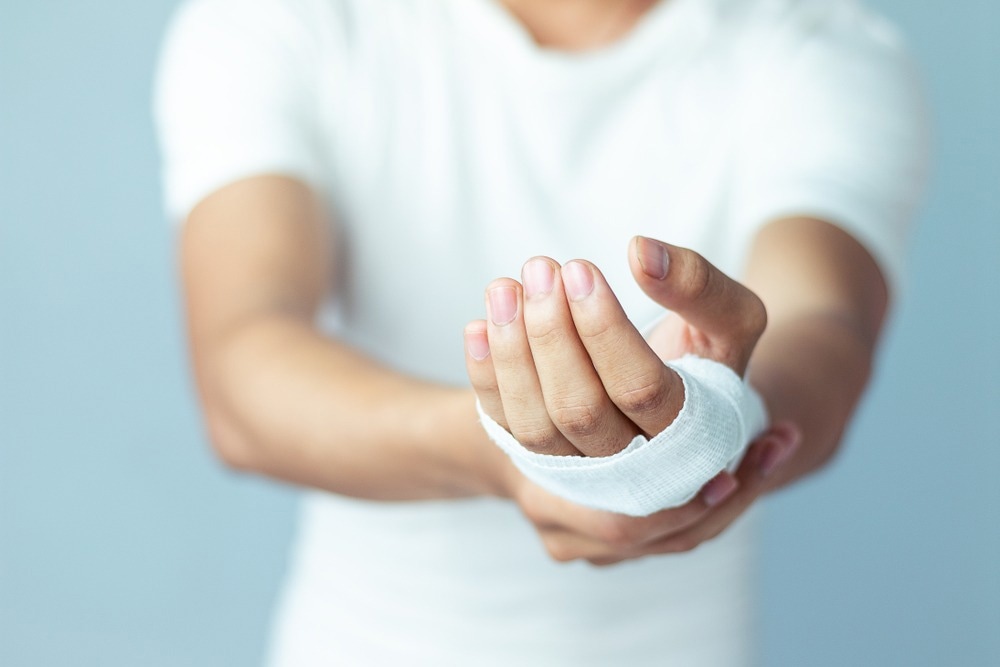Researchers develop a wearable bioelectronic system for wound healing treatment delivery
In a recent study published in Scientific Reports, researchers presented a wearable bioelectronic system to deliver therapeutic agents associated with wound healing.

Background
The production of wearable bioelectronics is a viable technique for improving treatment delivery. These systems may continuously supply ions, charged biological molecules, and an electrical current for several medicinal purposes. Quick prototyping of bioelectronic devices that can be worn for regulated administration of particular therapies with adequate scalability, on the other hand, is difficult.
About the study
In the present study, researchers developed a wearable system for bioelectronic delivery of treatment directed toward wound healing.
The system consisted of a three-dimensional (3D) printed custom polydimethylsiloxane (PDMS) delivery device integrated with a printed circuit board (PCB). Both the PCB and the PDMS had corresponding through-holes with metal connection pins covered in silver epoxy, permitting physical and electric integration. The modularly built system included solution-containing reservoirs, implanted electrodes, and capillary tubes filled with hydrogels.
The team demonstrated three designs for the PCB component: one wired and the other two powered by batteries with as well as without inbuilt memory. The PCB wired version used an externally located voltage controller to activate the device, whereas the one powered by batteries used a microcontroller unit (MCU) that enabled programmed voltages to be applied, as well as a deep sleep module to extend battery lifetime. The PCB powered by batteries with inbuilt memory was used to document delivered currents, enabling the verification of the therapeutic dosage delivered.
The devices were delivered hydrogen ions in C57B6 and wild-type murine models in vivo, and fluoxetine was delivered using simulated wound environments ex vivo. The PDMS was employed as a bridge between biological specimens such as a wound site and typical electrical components. Once a positive voltage was applied across the reference (RE) and working electrodes (WE), drug ions were pulled through the working electrode to the wound site as a substitute for indigenous sodium ions at the reference electrode.
Each PCB included four actuation pathways wherein current could be measured by connecting resistors in parallel with voltages supplied via the MCU or an externally located controller. The wired system relied on connecting the PCB to an external voltage controller and included computer-aided design (CAD) assemblies of the PDMS and PCB subsystems.
The PDMS device had four reservoirs to hold aqueous source solutions, through-holes to support cylindrical posts for electrical and mechanical interfacing with the PCB, hydrogel-filled capillaries for interfacing with the wound bed, and a protruding notch designed to sit in a recessed wound bed.
Results
The assembly method allows for the interchange of subsystem components, such as different PCB designs and reservoir solutions. Immunohistochemistry staining revealed a 36% improvement in the M1/M2 ratio of H+-treated wounds compared to control wounds, showing that the platform can potentially promote wound repair.
Particularly, the gadget may supply charged biomolecules, ions, and electric fields continuously in the in vivo as well as ex vivo settings. This stand-alone technology might be expanded to function as a component of the closed-loop-type wearable medicine delivery platform. Due to the modularity of the integration process, the PDMS device structure remained unaltered while the PCB was upgraded to achieve varied degrees of system capability. The platform could deliver ions when utilized in the wearable form in full-thickness, splinted wounds on murine models as a proof of concept.
The researchers proved the biocompatibility of the devices in contact with the wound. The manufacture of the polydimethylsiloxane device body and its connection with the PCB provides a dependable and scalable method for producing bioelectronic devices. Devices were effectively mounted to mouse wounds and activated for H+ administration, remaining undamaged and functioning throughout the trial. The overall H+ delivery efficiency was judged to be 22%.
The battery-powered system upgrade allowed for longer actuation durations and higher cumulative treatment dosages. The findings demonstrated that the technology successfully stimulated macrophages, which are essential for wound healing. The immunohistochemical staining findings revealed that the M1/M2 ratio of the H+-treated wounds was 36% lower on average when compared to the control wound.
The lower M1/M2 macrophage ratio implies that there was a relative increase of M2 macrophages in the treated wounds, which is known to enhance wound healing through tissue repair and regeneration. The results showed that the memory-enabled battery system could supply a charged biomolecule (fluoxetine) continuously for seven hours. Ag and AgCl wires are utilized as the WE and RE, respectively, to prepare the device.
Conclusions
Overall, the study findings showed that the platform's architecture allows for the substitution of customizable components while manufacturing provides a repeatable and scalable procedure, making it a flexible tool for a variety of therapeutic applications. Furthermore, using murine models, we demonstrate the potential of the proposed modular wearable bioelectronic system to promote wound healing by H+ administration in vivo.
Immunohistochemistry staining revealed that in vivo wounds treated with H+ provided by the battery-powered device had a 36% higher M1/M2 ratio than control wounds. Furthermore, the system's capacity to continually distribute charged biomolecules for up to seven hours ex vivo revealed the possibility for long-term therapeutic administration.
- Baniya, P. et al. (2023) "A system for bioelectronic delivery of treatment directed toward wound healing", Scientific Reports, 13(1). doi: 10.1038/s41598-023-41572-w. https://www.nature.com/articles/s41598-023-41572-w
Posted in: Medical Science News | Medical Research News | Disease/Infection News
Tags: Bioelectronic, Capillaries, Electrode, Ex Vivo, Hydrogel, Immunohistochemistry, in vivo, Macrophage, Manufacturing, Medicine, Sleep, Technology, Wound, Wound Healing

Written by
Pooja Toshniwal Paharia
Dr. based clinical-radiological diagnosis and management of oral lesions and conditions and associated maxillofacial disorders.